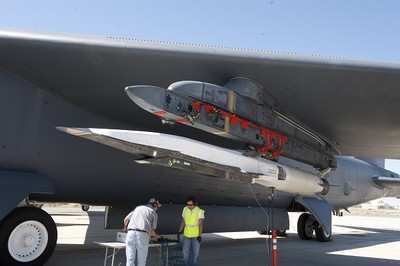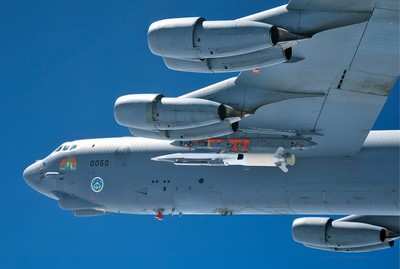Fri, Jun 17, 2011
Scramjet Failed To Develop Full Power
A second test of the X-51A Waverider flew June 13, 2011, in the
Point Mugu Naval Air Test Range over the Pacific Ocean, bringing
significant hypersonic research data in a less than successful
flight test. The hypersonic aircraft was successfully boosted to
just over Mach 5, and the scramjet engine lit but failed to
transition to full power.

Air Force Flight Test Center officials said after a flawless
flight from Edwards Air Force Base, a U.S. Air Force B-52H
Stratofortress released the experimental vehicle from an altitude
of approximately 50,000 feet. After release the X-51A was initially
accelerated by a solid rocket booster to a speed just over Mach
5.
The experimental aircraft's air breathing scramjet engine lit on
ethylene and attempted to transition to JP7 fuel operation when the
vehicle experienced an inlet un-start. The Waverider attempted to
restart and oriented itself to optimize engine start conditions but
was unsuccessful. The vehicle continued in a controlled flight
orientation until it flew into the ocean within the test range.

According to Charlie Brink, the Air Force Research Laboratory's
X-51A program manager, AFRL, Boeing and Pratt-Whitney Rocketdyne
engineers are reviewing the large amount of telemetry data
collected during the test flight to identify the cause of the
anomaly. "Obviously we're disappointed and expected better
results," said Mr. Brink, "but we are very pleased with the data
collected on this flight. I am extremely pleased with the AFFTC and
Point Mugu's support and execution of this complex flight test
mission, as they provided us every opportunity for success in this
endeavor. We have attempted two scramjet experiments now where one
successfully lit, and one did not. We will continue to examine the
data to learn even more about this new technology," he said. "Every
time we test this new and exciting technology, we get that much
closer to success."
Boeing and Pratt-Whitney Rocketdyne built four X-51A flight test
vehicles with the program goal of reaching Mach 6 in hypersonic
flight. The next flight is tentatively schedule for fall 2011.
More News
An Amazing Experience Awaits The Chosen Few... Oshkosh, to us, seems the perfect place to get started on watching aviation recover the past couple of years... and so ANN is putting>[...]
“NBAA has a tremendous responsibility to the business aviation industry, and we are constantly collaborating with them. Our flight departments, professionals and aircraft own>[...]
Dead Reckoning Dead reckoning, as applied to flying, is the navigation of an airplane solely by means of computations based on airspeed, course, heading, wind direction, and speed,>[...]
Aero Linx: Vertical Aviation Safety Team (VAST) We are a public–private initiative to enhance worldwide flight operations safety in all segments of the vertical flight indust>[...]
We're Everywhere... Thanks To You! Even with the vast resources and incredibly far-reaching scope of the Aero-News Network, every now and then a story that should be reported on sl>[...]
 ANNouncement: Now Accepting Applications For Oshkosh 2024 Stringers!!!
ANNouncement: Now Accepting Applications For Oshkosh 2024 Stringers!!! Aero-News: Quote of the Day (06.13.24)
Aero-News: Quote of the Day (06.13.24) ANN's Daily Aero-Term (06.13.24): Dead Reckoning
ANN's Daily Aero-Term (06.13.24): Dead Reckoning ANN's Daily Aero-Linx (06.13.24)
ANN's Daily Aero-Linx (06.13.24) ANN FAQ: How Do I Become A News Spy?
ANN FAQ: How Do I Become A News Spy?




